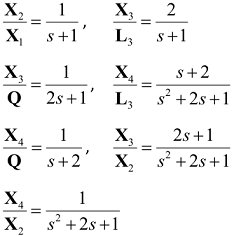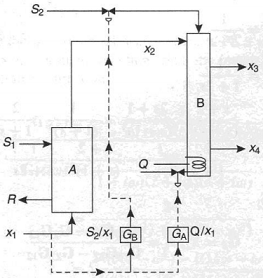Reference no: EM132506165
Assignment - Chemical Engineering Question
A continuous process consists of two sections, A and B, shown in the figure below. Feed of composition X1 enters section A where it is extracted with a solvent pumped at a rate L1 to A. The raffinate stream is removed from A at a rate L2, whilst the extract is pumped to a cracking section B. Hydrogen is added at the cracking stage at a rate L3 whilst heat is supplied at a rate Q. Two products are formed, having compositions X3 and X4. The feed rate to A, along with L1 and L2, can be kept constant easily, but it is known that fluctuations in X1 can occur. Consequently, a feed-forward control system is proposed to keep X3 and X4 constant vis-à-vis variations in X1, using L3 and Q as controlling variables. Experimental frequency-response analysis yielded the following transfer functions:

where X1, X2, L3, Q, etc. denote the Laplace transforms of small time-dependent perturbations, i.e., deviations about steady-state, in the variables X1, X2, L3, Q.

Determine the transfer functions of the feed-forward control scheme, assuming linear operation and negligible distance-velocity lags throughout the process. Comment on the stability of the feed-forward controllers which you specify.